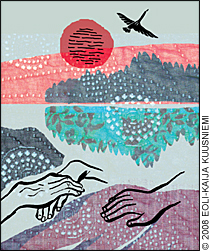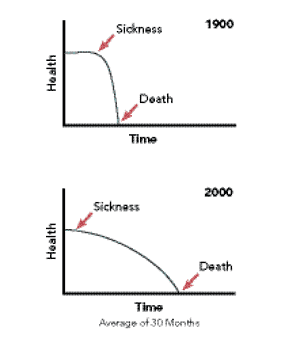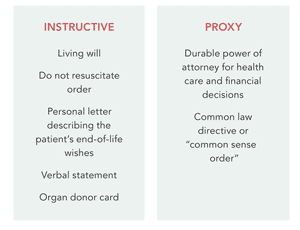
The conversation may not be easy, but your patients will be grateful.
Fam Pract Manag. 2008;15(3):18-22
Dr. Old is a clinical assistant professor at the University of Kansas School of Medicine, Department of Family Medicine, Kansas City, Kan. He is the consulting chief medical officer for Hospice Care of Kansas and Hospice Care of the Midwest. Author disclosure: nothing to disclose.

Demographic shifts are changing family medicine. For the first time in history, people older than 85 represent the fastest growing segment of our population. People are now living an average of 30 months after they receive a terminal diagnosis (see “Dying trajectories from 1900 and 2000”). The economic impact of these trends is staggering. One study found that after age 65 a patient (or the system) pays $145,000 for each additional year of life gained.1 Yet despite the medical advances that have extended patients' lives, the mortality rate (at least in my practice) is still 100 percent.
Demand for end-of-life care is greater than ever, and family physicians are uniquely suited to provide it. The longevity of our physician-patient relationships and the whole-person orientation that was fundamental in our training enable us to communicate with our patients in ways that many other physicians can't. This article describes how to embrace end-of-life care and develop the skills that can make us expert at providing it.
Predicting life expectancy
Predicting life expectancy is one of the biggest challenges in end-of-life care. One study found that we overestimate life expectancy 63 percent of the time.2 Primary care physicians may have an especially hard time predicting life expectancy because of the close relationships we have with our patients. Fortunately, tools and guidelines to help us do this more objectively are emerging.
The Palliative Performance Scale (PPS) (available online at http://www.victoriahospice.org/ed_publications.html) is reasonably accurate for patients who are beginning to show functional decline. Individuals with a PPS score of less than 50 percent often die within six months. General guidelines for predicting life expectancy can be found at the National Hospice and Palliative Care Organization Web site (http://www.nhpco.org) or the American Academy of Hospice and Palliative Medicine Web site (http://www.aahpm.org).
Key clinical indicators can also help you gauge the life expectancy of your patients. It is particularly indicative of a life expectancy of six months or less if you observe any of the following general criteria in patients with chronic illnesses: unintentional weight loss of 10 percent or more of total body weight, recurrent infections (e.g., aspiration pneumonia, infected decubitus or pyelonephritis), increasing hospitalizations, serum albumin less than 2.5 and functional decline.
It can also be useful for experienced physicians to ask themselves, “Would I be surprised if this patient died in six months?” If the answer is “no,” evaluation for hospice or palliative care may be appropriate.
The way you present your prognosis to the patient is also important. It is undesirable, and even dangerous, to give a patient an exact prediction of the length of time he or she has to live (e.g., “You have three months to live”). But it is reasonable to be as specific as possible by suggesting months rather than years, weeks rather than months, etc. Most patients appreciate full disclosure and do not want a prognosis that is overly optimistic.3
Many physicians believe that death should be avoided instead of embraced as a natural part of life. This mindset can make predicting life expectancy difficult at first. However, if we begin observing end-of-life stages with the same interest that we have for other disorders, we will quickly develop clinical prognostic skills comparable to our clinical judgment in other areas. Talking with patients about life expectancy will always be difficult, but it is a skill we can improve with attention and experience.
DYING TRAJECTORIES FROM 1900 AND 2000
Dying has become more complex and takes longer.

Source: Corr CA. Death in modern society. In: Doyle D, Hanks G, MacDonald N, eds. Oxford Textbook of Palliative Medicine. 2nd ed. New York, NY:Oxford University Press Inc; 1998:31-40.
Initiating the hospice conversation
One of the most difficult things we do as physicians is deliver bad news to our patients and their families. It is often much easier for us to continue pursuing an unlikely cure than to have the difficult conversation about allowing a natural death. However, the wise physician knows when to transition from cure to palliation, and patient and family satisfaction increase when this transition is made.4
When a terminal diagnosis is given, most patients understand what this means and are grateful for their physician's honesty. As physicians, we often worry about taking away the patient's hope, but we should not be partners in spreading false hope. Redirecting the patient's focus from “cure” to a more reasonable goal such as living long enough to complete certain tasks (e.g., heal relationships or witness events) can be helpful. Even a pain-free death could be a goal. The literature confirms that it is possible to have both quality of life and quantity of life. A recent study has established that patients receiving hospice care actually live longer than their counterparts who are pursuing aggressive treatment.5
SUGGESTED READING IN AMERICAN FAMILY PHYSICIAN
Before you begin the conversation about hospice or palliative care, several practical details should be carefully considered:
Make time. These conversations should not be rushed.
Make space. Choose a private, quiet place where everyone can be seated.
Turn off your cell phone and pager. Remove any items from the room that might cause a distraction or interruption.
The conversation itself deserves ample forethought. Spend a few minutes imagining how it might unfold. Plan to spend as much time listening as you do talking. You may want to follow an outline like this one:
Find out what the patient knows. Start the conversation by finding out what the patient and family understand about the diagnosis. You could ask, “What is your understanding of your condition?” or “What have you been told about your disease by the other doctors you've seen?”
Listen carefully to the patient's response. If there is a big disparity between what the patient feels his or her prognosis is and what you think it is, the conversation is going to take some time. Speak slowly and clearly, and be sensitive to older patients' hearing challenges.
Discover the patient's goals. This is the key to good palliative care, and it requires strong listening skills. Once you know the patient's goals, there may be numerous ways of helping the patient meet them. If the goals are for palliation, then additional help from a hospice organization can be extremely valuable. It is best to determine the patient's goals first and then match his or her goals with what hospice can offer, rather than listing what a hospice can do and trying to make the patient's goals fit into the hospice model.
Billing for the hospice conversation
The hospice conversation, in Current Procedural Terminology (CPT) terms, is a counseling and coordination of care activity. When providing this service, document your total face-to-face time with the patient and the amount of that time devoted to discussing hospice. If the latter accounts for more than 50 percent of the total time, it may be best to choose a level of service based on time rather than on the levels of history, exam and decision making you provided during the visit.
BILLING FOR HOSPICE CARE
Unless you refer your hospice patients to other physicians, they may designate you as their attending physician. Attending physicians work with the hospice nurse case manager and the hospice medical director to care for their patients. As the attending physician, you will play the most significant role in determining and delivering your patients' medical care. Billing for patients enrolled in Medicare-approved hospice works like this:
The hospice bills Medicare Part A.
The attending physician continues to bill Medicare Part B, appending the following modifiers to CPT codes as appropriate:
GV for related conditions;
GW for unrelated conditions;
Q5 in conjunction with modifier GV or GW when another physician acts on behalf of the attending physician (e.g., call coverage);
Q6 in conjunction with modifier GV or GW when a locum tenens acts on behalf of the attending physician;
26 for providing the professional component of a service (e.g., lab, X-ray).
If the attending physician and hospice medical director see the patient on the same day, the attending physician should bill the ICD-9 code that reflects the diagnosis and the hospice medical director should bill the ICD-9 codes that reflect the patient's symptoms.
Medicare carriers make payments to the attending physician or beneficiary, as appropriate, based on the payment and deductible rules applicable to each covered service. When reporting services that have professional and technical components, the professional component is billed to Medicare Part B and the technical component is billed to the hospice. For example, if you provide a two-view chest X-ray in your office related to the terminal diagnosis of your hospice patient, you might report the professional component (interpretation and report) to Medicare using code 71020-26-GV, and bill the hospice for the technical component, or 71020-TC. If the reason for the chest X-ray was not related to the patient's terminal condition, you would report 71020-GW.
As the attending physician, you can also bill for care plan oversight if you are the physician who signed the hospice plan of care. You should report CPT code 99377, “Physician supervision of a hospice patient (patient not present), 15 to 29 minutes per month,” or CPT code 99378, “30 minutes or more per month, for non-Medicare services.” Medicare requires reporting G0182, “Greater than or equal to 30 minutes per month, for physician supervision of a patient's care plan under a Medicare-approved hospice.” For more information on the requirements for documenting and billing care plan oversight services, see “How to Document and Bill Care Plan Oversight,” FPM, May 2005.
If you are under contract with a hospice to serve as its medical director (even if you do this work as a volunteer), you must bill the hospice (not Medicare) for any activities you do as medical director, such as attending team meetings, approving eligibility for hospice or seeing patients at the request of the hospice. The hospice will pay you directly according to the contracted amount and bill Medicare Part A. Keep in mind that if you are both the hospice medical director and a patient's attending physician, you cannot bill for care plan oversight for that patient for any services you provide.
Explaining advance directives
Advance directives allow your patients to document their wishes at the end of life. People are often confused about the types of advance directives, but they are fairly simple. (See “Types of advance directives.”) An instructive advance directive requires the patient to write down or tell someone what he or she wants (e.g., a living will). A proxy advance directive (e.g., durable power of attorney) enables the patient to select someone to make decisions on his or her behalf if the patient is unable to do so. Unless the patient's estate is complicated, an advance directive can be completed without a lawyer.
The best time to talk to patients about advance directives is before the end-of-life stages, or even during routine physical exams. You might begin the conversation like this: “I talk with all of my patients about advance directives before one may be needed. Have you thought about completing one?” This lets the patient know that advanced planning is socially and medically acceptable, and encourages him or her to think about and complete an advance directive.
TYPES OF ADVANCE DIRECTIVES
There are two main types of advance directives:

The rewards
End-of-life care means reaching patients in their most personal and vulnerable times. When a patient knows death is near, it is a time of tremendous personal growth. Helping patients during this journey can be one of the most rewarding things physicians do in medicine. It requires becoming comfortable with our own mortality and removing barriers between ourselves and our patients. Physicians who practice end-of-life care know it is OK to become attached to their patients and to feel the human emotions they feel.
Knowing when to stop aggressive therapies and embrace symptom management, end-of-life support and education is noble. If we focus on curing all pathology, we will always eventually lose. If we concentrate on providing quality of life for our patients, even as death approaches, we will all win.